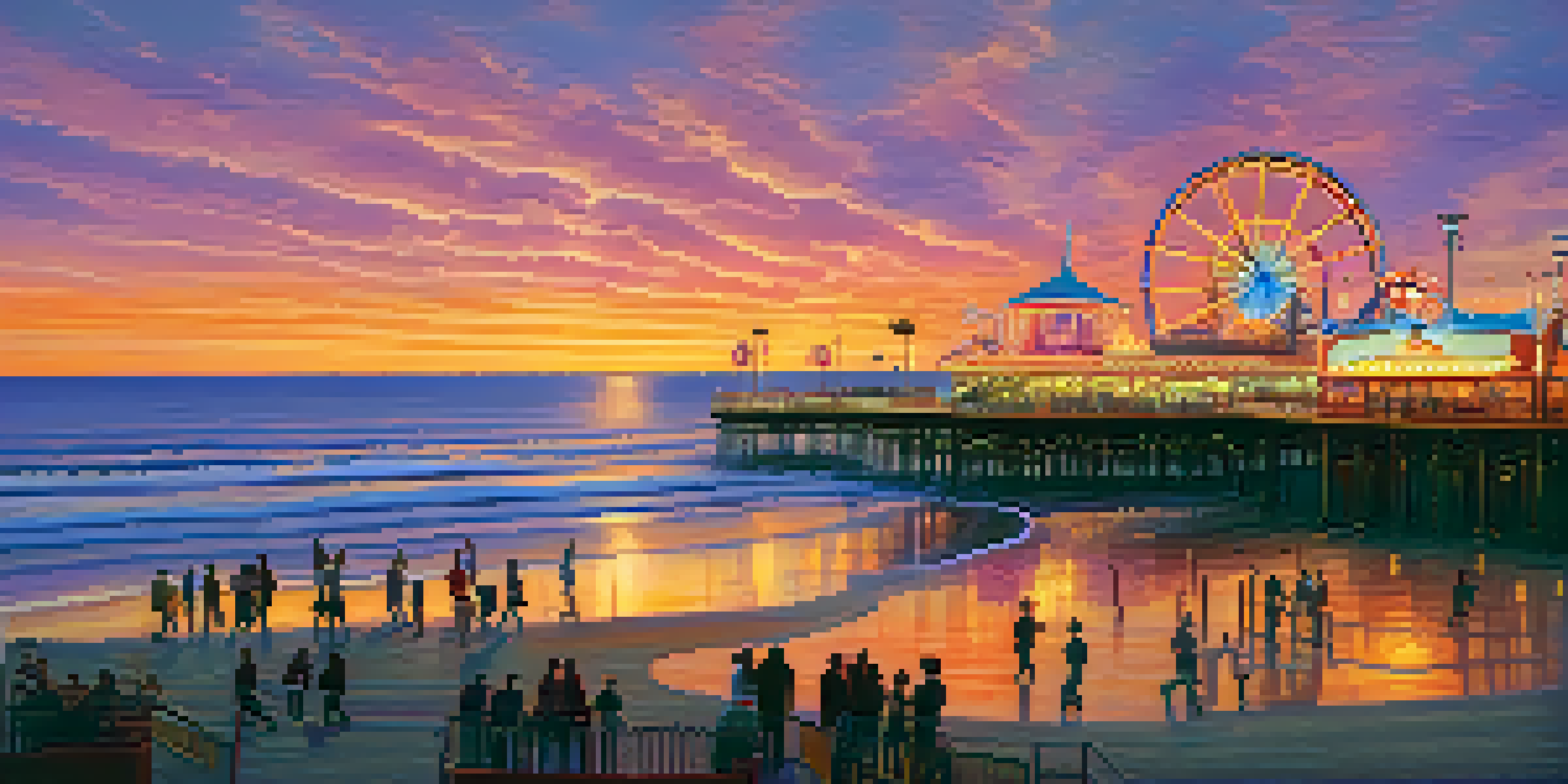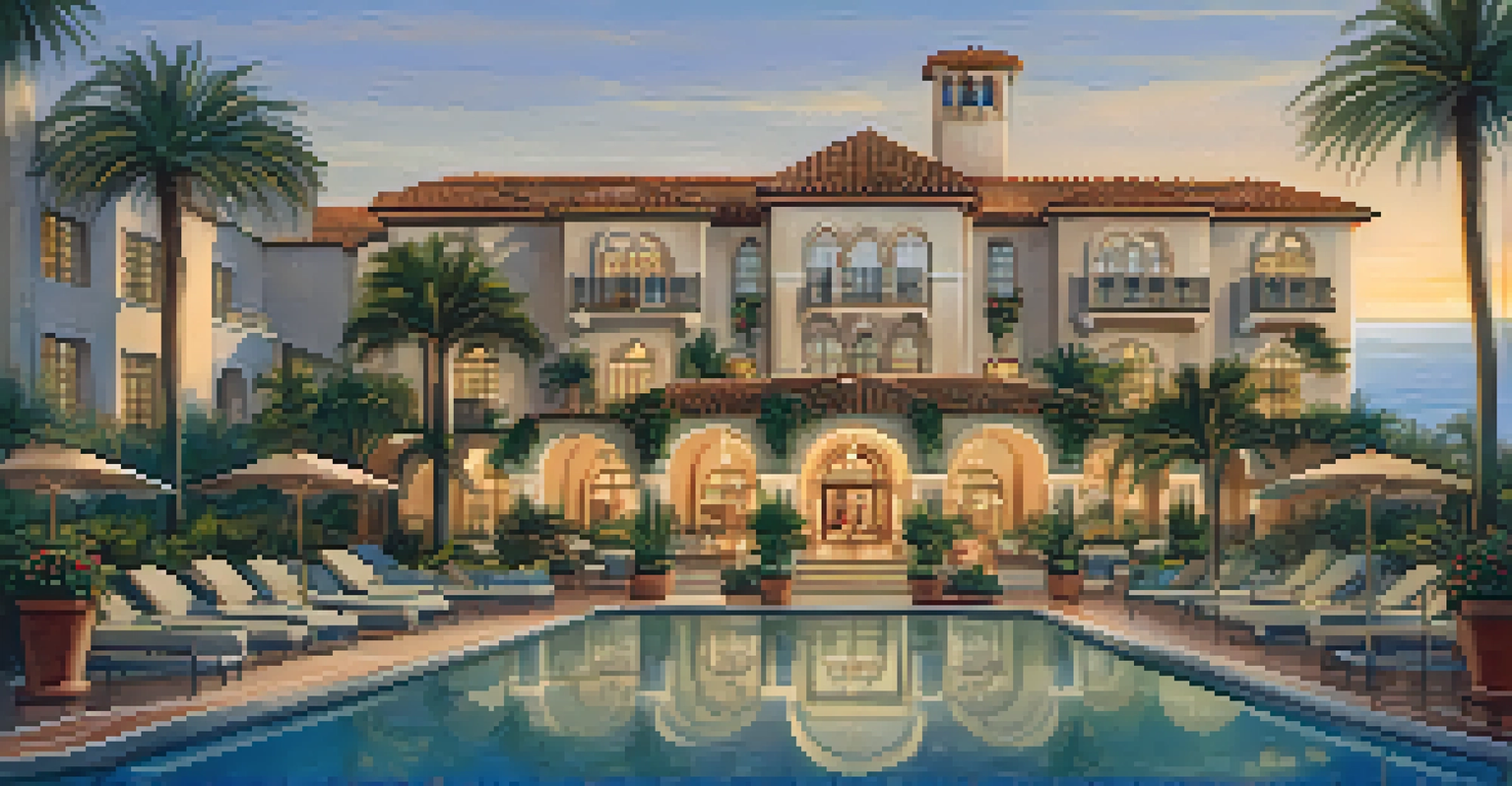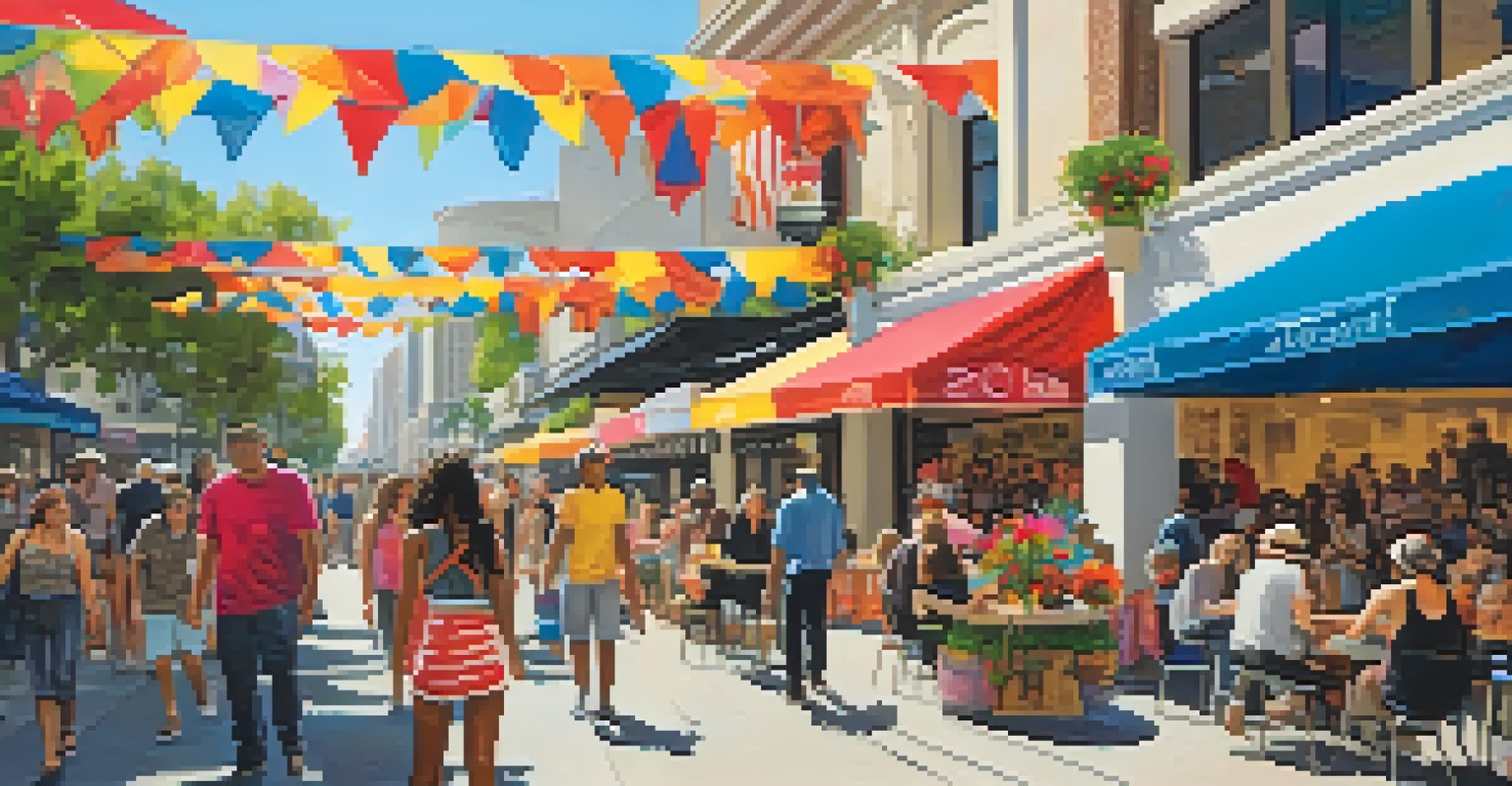Historic Venues in Santa Monica: A Look at Cultural Heritage

The Iconic Santa Monica Pier: A Historical Landmark
The Santa Monica Pier is more than just a fun destination; it's a historical landmark that has been welcoming visitors since 1909. Known for its vibrant atmosphere, the pier features the famous carousel and an amusement park, but its significance goes beyond entertainment. It has witnessed countless events, from military send-offs during World War II to cultural festivals that celebrate the local community.
History is not a burden on the memory but an illumination of the soul.
Walking along the pier, you can almost hear the whispers of history, as it has served as a backdrop for numerous films and television shows. This iconic structure stands as a testament to Santa Monica's evolution over the decades, seamlessly blending nostalgia with modernity. It's a perfect spot for both locals and tourists to enjoy the ocean views while soaking in the past.
Moreover, the pier is a hub for various cultural activities, ensuring that the spirit of Santa Monica continues to thrive. From art installations to live music performances, the pier is a lively venue that brings people together, showcasing the city's dedication to preserving its cultural heritage while embracing new experiences.
The Historic Casa Del Mar: A Glimpse into the Past
Casa Del Mar is a stunning hotel that exudes old-world charm and elegance, dating back to the 1920s. This former beach club has been beautifully restored, allowing visitors to experience a slice of Santa Monica's rich history. The hotel's architecture reflects the Mediterranean style, making it a visual delight that draws attention from all around.

Guests can enjoy luxurious accommodations while being surrounded by artifacts that speak to the hotel's storied past. The lobby features vintage decor that transports you back in time, making it a favorite for history buffs and romantic getaways alike. Dining at the hotel's restaurant offers a taste of local cuisine, all while gazing out at the stunning coastline.
Historical Significance of Santa Monica
The Santa Monica Pier and other landmarks illustrate the city's rich history, serving as cultural hubs that connect the past with the present.
Casa Del Mar not only provides a glimpse into Santa Monica's luxurious past but also hosts events that celebrate its heritage. From art exhibits to classic film screenings, the hotel serves as a venue that keeps historical conversations alive, ensuring that the legacy of this beautiful location continues to be appreciated by future generations.
The Santa Monica History Museum: A Treasure Trove of Stories
The Santa Monica History Museum is a must-visit for anyone looking to dive deeper into the local heritage. This small but powerful museum showcases artifacts, photographs, and exhibits that tell the story of Santa Monica's development from a small beach town to a bustling city. It's a place where you can connect with the community's past in a meaningful way.
Preservation of one's own culture does not require contempt or disrespect for other cultures.
Interactive exhibits engage visitors of all ages, making history come alive. From exploring the city’s original inhabitants to the impact of the Santa Monica Pier, the museum highlights the diverse narratives that have shaped the area. It’s an educational experience that fosters an appreciation for the city’s cultural evolution.
In addition to its permanent collection, the museum hosts events and workshops that aim to preserve and promote local history. By participating in these activities, visitors can contribute to the ongoing dialogue about Santa Monica’s heritage, making the museum a vital part of the community and a keeper of its stories.
The Cultural Impact of the Third Street Promenade
The Third Street Promenade is not just a shopping destination; it’s a cultural hub that showcases Santa Monica’s vibrant spirit. This pedestrian-only street has been a gathering place for locals and tourists alike since its opening in the 1960s. The promenade features street performers, art installations, and a variety of shops, making it a lively spot full of energy and creativity.
Historically, the area has served as a focal point for cultural events, including art fairs and music festivals, reflecting the community's commitment to the arts. These events not only entertain but also highlight local talent, drawing attention to the city’s rich artistic heritage. It’s a place where the past meets the present, fostering a sense of community and belonging.
Community Engagement in Preservation
Local initiatives and community involvement play a crucial role in preserving Santa Monica's cultural heritage for future generations.
As you stroll down the promenade, you’ll find various venues that celebrate cultural diversity, from galleries showcasing local artists to theaters presenting thought-provoking performances. This blend of commerce and culture encapsulates the essence of Santa Monica, making it a key player in the city’s ongoing narrative of growth and change.
The Beautiful Architecture of the Santa Monica Civic Center
The Santa Monica Civic Center is a striking example of modernist architecture, showcasing the city’s commitment to blending contemporary design with historical significance. Opened in the 1970s, this complex includes the City Hall, library, and cultural venues, creating a space that serves both administrative and artistic purposes. Its unique design makes it a landmark worth exploring.
Visitors can appreciate not only the stunning architectural features but also the public art installations that enhance the surroundings. The Civic Center often hosts events that celebrate local culture, from farmers' markets to community festivals, making it a dynamic space that brings people together. It stands as a symbol of the city’s dedication to fostering civic engagement and cultural appreciation.
Moreover, the Civic Center has been a focal point for discussions about urban development and sustainability, reflecting Santa Monica's forward-thinking approach. It’s a venue that encourages dialogue about the future while honoring the past, ensuring that the city continues to evolve while staying rooted in its cultural heritage.
The Historic Annenberg Community Beach House
The Annenberg Community Beach House is a hidden gem that offers a glimpse into Santa Monica's glamorous past. Originally built in the 1920s as a beachside estate for actress Marion Davies, this venue has been transformed into a community space that embraces its historical roots. Today, it features a beautiful pool, a café, and stunning beachfront views, making it a perfect spot for relaxation and recreation.
Visitors can explore the historic guesthouse and learn about its fascinating history through guided tours and exhibits. The Beach House serves as a reminder of Hollywood's golden age while also providing a venue for community events that celebrate local culture. Its blend of history and modern amenities makes it a unique destination on the Santa Monica coast.
Cultural Vibrancy at Third Street
The Third Street Promenade stands as a dynamic cultural center, blending shopping, entertainment, and artistic expression in Santa Monica.
In addition to its historical significance, the Annenberg Community Beach House promotes environmental stewardship and sustainability. Offering programs that educate visitors about the ocean and beach ecology, it ensures that the legacy of this beautiful location continues to include a commitment to the environment, bridging the past and future in a meaningful way.
Influence of the Santa Monica Mountains on Local Heritage
The Santa Monica Mountains play a significant role in shaping the cultural heritage of the area. These majestic mountains not only provide a stunning backdrop for the city but also have historical importance that dates back to the native Tongva people. The mountains are rich in biodiversity and have been a source of inspiration for artists, writers, and naturalists throughout history.
Exploring the trails and parks in the mountains reveals fascinating stories about the region's past, including the early settlers and the conservation efforts that have taken place over the years. Many hiking paths include interpretive signs that educate visitors about the flora and fauna, as well as the historical significance of the land. This connection to nature enhances the cultural narrative of Santa Monica.

The mountains also serve as a venue for various community events, such as outdoor concerts and festivals that celebrate local culture. By fostering a love for the outdoors while honoring its historical context, the Santa Monica Mountains contribute to the rich tapestry of the city’s heritage, ensuring that the natural and cultural elements are intertwined for future generations.
Preserving Santa Monica's Cultural Heritage for Future Generations
Preserving Santa Monica's cultural heritage is a collective effort that involves the community, local organizations, and government initiatives. Through various programs and projects, the city aims to maintain its historical sites and educate residents about their significance. This commitment ensures that the unique stories of Santa Monica continue to be told and celebrated.
Collaborative efforts, such as community workshops and fundraising events, engage residents in the preservation process. These initiatives not only raise awareness but also foster a sense of pride and ownership in the local heritage. By bringing people together, Santa Monica creates a supportive environment that values its past while looking toward the future.
Ultimately, preserving cultural heritage is about creating connections between generations. By instilling a sense of appreciation for local history in younger residents, Santa Monica ensures that its rich cultural legacy will continue to thrive. This ongoing dialogue between the past, present, and future is what makes Santa Monica a truly special place.